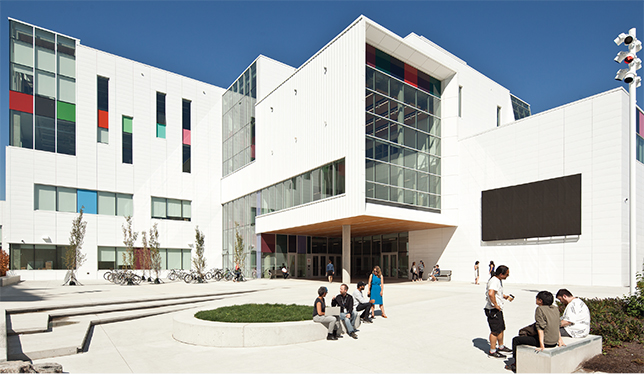This past September, after hundreds of meetings, years of deliberations and untold hours of planning, Emily Carr University of Art + Design’s new campus on Vancouver’s False Creek Flats opened its doors for the first time. The big campus move has been part of Ron Burnett’s life for 16 of the 21 years he’s been president of the university.
When it originally established itself as the Vancouver School of Decorative and Applied Arts in 1925, ECUAD operated on the top floor of the downtown headquarters of the Vancouver School Board. So began decades of the art school operating on leased or temporary land, most recently on Granville Island, home to a public market and artist studios, where ECUAD students and faculty occupied a series of dense, squat buildings since 1980. Now, as of this fall, the campus has a purpose-built, permanent home of its own. “We own the land that the campus is sitting on, which is very, very significant in the history of the institution,” said Dr. Burnett.
The airy, four-storey, 27,000-square-metre campus stretches across two city blocks, with light shining in from all directions. Situated on industrial land that was the former site of a rail yard, the new campus marks renewal for this relatively underdeveloped part of the city.

ECUAD faculty members and Vancouver artists Landon Mackenzie and Ben Reeves were behind the colour selection on the facade of the new building. The 15-colour palette reflects and honours the work of B.C. painter and campus namesake Emily Carr. Inside, three floor-toceiling atria bring natural light indoors, and two sprawling outdoor plazas mark a new step forward for large-scale public gathering spaces on the city’s east side, which, as Dr. Burnett explained, has relatively few compared to Vancouver’s tonier west side and downtown.
Designed by Canadian architecture firm Diamond Schmitt Architects, the $122.6-million campus intentionally blurs the lines between life inside the school and the Vancouver that surrounds it – a city that, for all its mountains-and-ocean beauty, lacks the artistic verve typical of major urban centres. “Vancouver is bereft of different cultural infrastructure, and that’s very unfortunate,” said Dr. Burnett. To him, ECUAD’s new campus could serve to address that lack.
This symbiosis between the city’s main art school and its surrounding community reverberates on an even grander scale in Toronto, where OCAD University is undergoing an extensive campus rebuild on the university’s downtown properties on McCaul Street. Called Creative City Campus, the project will renovate and repurpose approximately 8,800 square metres of university facilities while adding 4,600 square metres of new construction.
“We’re in this particular moment where a lot of planning has gone into this, and now we’re really excited because it’s actually being realized,” said OCAD U president Sara Diamond. Much of the rebuild is informed by a desire “to create a lot of flow-through and opportunities for the public to interact with the school, to make it more porous and integrated, and to also increase sustainability and decrease our carbon footprint,” she said.
The Creative City Campus is one of several ongoing projects. Its waterfront expansion, called Campus for the Connected World, is currently in its first phase of development that is scheduled for completion in April 2018. Like ECUAD’s new campus in Vancouver, OCAD U’s Campus for the Connected World will be part of an urban renewal process for an underdeveloped part of the city, in this case on Toronto’s waterfront. The hope is for it to act as a hub to connect the creative community and technology sector, said Dr. Diamond, “to look at next-generation technologies from a human perspective.”
The key to this work will be deep, cross-sectoral integration with the City of Toronto and with its technology, science, engineering and healthcare sectors, said Dr. Diamond. As well, OCAD U’s new academic plan seeks to provide more dynamic experiential learning opportunities to its students. Those opportunities, she said, could help students to find employment across a variety of sectors upon graduation.
With some 4,400 students (both full-time and part-time), OCAD U has roughly twice the student population as ECUAD. Further east, the Nova Scotia College of Art and Design in Halifax is considerably smaller, with about 800 students enrolled as of 2016. It underwent its own waterfront expansion, called the Port Campus, in 2007. However, the main campus remains a series of cramped Victorian-era buildings it has occupied in downtown Halifax since the 1970s. Questions abound about the prospect of moving the full campus to the port lands; however, at the time of this writing, NSCAD University president Dianne Taylor-Gearing advised University Affairs that it would be premature to discuss the institution’s future plans for now.
With so much focus on the next iteration of the country’s art and design schools, it’s easy to forget their deep roots in Canada. OCAD U opened in 1876, NSCAD in 1887, and ECUAD in 1925. In the decades since then, much has changed in how we think about art and its role in shaping a city. ECUAD’s Dr. Burnett, who steps down as president in July 2018, said the central notion guiding all of the recent changes to his campus is “the importance of art and design for our citizenry.” To him, it’s as essential as the air we breathe. “I don’t know how you can live your life without watching the creative output of others,” he said.